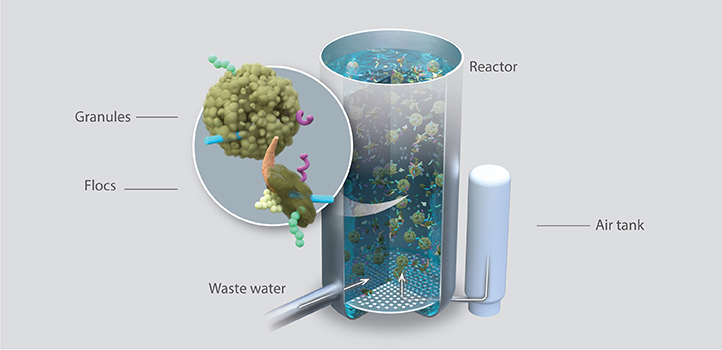

This microbial granular system converts wastewater for urban re-use, such as urban agriculture and landscaping.
The movers and shakers of wastewater treatment
The dynamics behind microbial communities in granular-based wastewater treatment systems.
The microbial communities in a new type of wastewater treatment system are shaped mostly by local factors, according to new research from Pascal Saikaly’s lab at KAUST. Understanding the microbial ecology of these systems will offer clues to help engineers improve them, a pressing need in the face of urbanization and population growth.
Researchers at the Water Desalination and Reuse Center and their international collaborators used mass balance calculations and gene sequencing to study the microbial communities in an aerobic granular sludge (AGS) system in the Netherlands. Their more efficient treatment means AGS systems, in which bacteria are mostly suspended rather than clumped, are gradually replacing conventional activated sludge systems, but “So far nobody has investigated the microbial ecology of these next-generation wastewater treatment systems,” says Muhammad Ali, the study’s lead author.
The team’s analysis over the six-month period showed that the microbial communities in aggregates throughout the treatment reactor differed significantly from those in the incoming wastewater. The communities could be placed along a gradient from the smallest aggregates (called flocs) that were most similar to the wastewater and the difference increased as the aggregates grew into larger granules. This led the team to conclude that community composition was mainly shaped by local habitat conditions in the aggregates (a process called species sorting) rather than by regional factors, such as immigration from the source.
The difference between flocs and granules of different sizes is mainly driven by how long they are retained in the reactor. For example, “Larger granules stay in the reactor for a longer time, giving a chance to slow-growing groups responsible for removing nutrients like nitrogen or phosphorus to duplicate and grow,” explains Ali. This highlights aggregate retention time as a key parameter for environmental engineers aiming to optimize these systems.
For Ali, the study provides important baseline data about AGS systems while also addressing important questions about community composition in microbial ecology. “This story starts with natural systems,” he says, “Biological wastewater treatment plants provide a nice model system, which allows us to investigate fundamental ecological principles.”
The specific contributions of aggregates of different sizes will now be studied by running a pilot reactor at KAUST. “Understanding the operating dynamics of AGS microbial communities is very important at this stage. This technology will replace existing systems, and by answering these fundamental questions, we can optimize its performance,” Saikaly explains.




